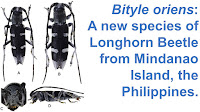Arums of the genus Pothos are hemiepiphytic vines (Plants which begin life as epiphytes growing upon other plants, but which as they grow stronger become self-supporting) found in tropical and subtropical forests in South China, Southeast Asia, Austrolasia, Oceana, and Madagascar.
In a paper published in the journal PhytoKeys on 15 October 2024, Maria Melanie Medecilo-Guiang of the Center for Biodiversity Research and Extension in Mindanao and Plant Biology Division at Central Mindanao University, and Derek Cabactulan of Cagayan de Oro City, describe a new species of Pothos from Bukidnon Province on Mindanao Island, Philippines.
The new species was first noted as possibly significant on the basis of its remarkable inflorescence, by conservationist and eye surgeon Miguel De Leon at a Robert S. Kennedy Bird Conservancy site in Bukidnon Province during an ornithological expedition in 2019. A subsequent expedition to the same site in February 2024 collected samples of the plant, from which it has been confirmed to be a new species. This is named Pothos deleonii, in honour of the initial discoverer.
Pothos deleonii is a root climbing, fibrous liana, with slender, slightly woody, green stems from which slender leaves arise on petioles (leaf stems) at regular intervals. Roots are found along the stem when the plants are young, but become less common as the Plant matures, and tend to be absent around inflorescence-producing termini. Inflorescences are born singularly on elongated peduncles (flower stalks) which hang 16-18 cm below the stem. These inflorescences are a dark wine red, aging to purplish black, with a spadix (spike with a large number of small flowers) up to 6.9 cm long, surrounded by a spathe (petal-like structure) up to 10 cm long and 5.5 cm wide.
Pothos deleonii was found growing at only two locations, climbing on the base and trunks of Tree Ferns of the genus Alsophila, in an area of degraded secondary, open-canopy Dipterocarp forest, at altitudes of 1150 and 1270 m above sealevel. Once the vines reach about 4-6 m in height they become independent of their host, able to stand free, either on their own base or supported by the surrounding tree canopy.
Both known sites are within a 5 km² area in the northern foothills of Mt. Kitanglad. This area is protected, and monitored by the Robert S. Kennedy Bird Conservancy, and not considered to be under any threat. However, on the basis of the low number of specimens discovered, and the limited area within which it is found, Medecilo-Guiang and Cabactulan recommend that Pothos deleonii is classified as Critically Endangered under the terms of the International Union for the Conservation of Nature's Red List of Threatened Species.
See also...









%20(1)%20(1).png)